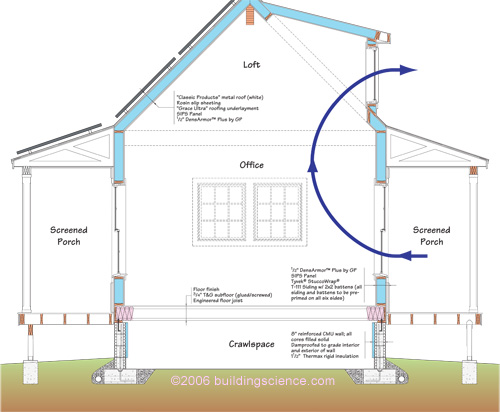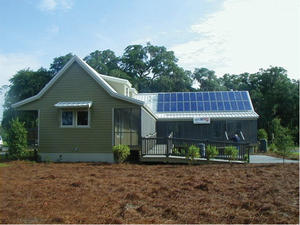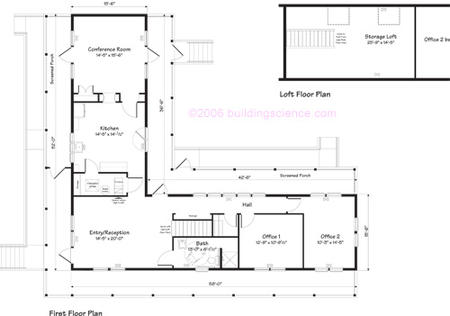You may have heard of ultra low energy buildings*—energy self-sufficient, solar-powered structures; buildings without utilty bills, or well on their way to that end. But you look at your own utility bills and the cost of solar energy systems, and you wonder just how this can work. There are four essential ingredients to making an Ultra Low Energy building work:
The Ultra Low Energy building is primarily powered by photo-voltaic and solar hot water systems, both likely mounted on the roof.
The Ultra Low Energy building is so efficient—as much as 90% more efficient than the average structure—that demand for power can be met, or nearly met, with readily available and reasonably sized solar power systems.
The Ultra Low Energy building always needs a back-up—some energy from the grid in the case of the Administration Building—to deal with times when the weather and the big energy demands (space heating or cooling, water heating, and refrigeration) combine and conspire.
The fourth ingredient is you. To tread this lightly on the land requires that you are a part of the system, tuning your energy use to complement rather than stress the Ultra Low Energy building. This does not mean thermal privation or hand-cranking your radio—it means learning a lot about how your home or office works, occasionally outwitting the big energy demands, and maybe expanding your comfort zone just a bit.
So, the trick is to stock your roof with panels; your home or office with the most efficient and integrated exterior envelope, HVAC system, water heater, appliances, and lighting available; and your family or co-workers with zero energy savvy. You will have to do all three. Here is what it takes to do each.
Key Features
- photovoltaic system;
- solar hot water heating;
- design for passive cooling and lighting;
- ducts in conditioned space;
- controlled ventilation;
- high performance envelope, windows and integrated HVAC system;
- advanced framing with structural insulated panels (SIPs);
- designed to promote natural ventilation/controlled mechanical mechanical ventilation for back-up.
Ultra Low Energy Building Performance
Although most people associate the term zero energy with solar panels, the starting point must always be the efficiency of the structure and its heating/ventilation/air conditioning (HVAC) system. The way to really fine-tune the energy performance of a building is to treat the structure andthe HVAC system as integrated systems, matching their features and individual contributions to the whole.
- deep wrap-around porches and window awnings for maximum shading and lots of indirect daylighting;
- number and location of operable windows (for cross ventilation) and high ceilings (for stack effect ventilation);
- highly reflective white standing seam metal roof cladding. These all work to reduce the need for mechanical cooling and electric lighting.

2. The HVAC system – Building a high-performance structure allows you to really fine tune or “right-size” your space heating and cooling unit, your fresh-air ventilation, and the ducts that deliver all three. Essential elements to the Administration Building include a variable-speed ECM air handler, a two-stage 13.25 SEER/8.95 HSPF heat pump unit, and a scheduled intermittent out-side air ventilation system that also provides mixing of all interior air. Mechanical ventilation, you say? You can’t build this tight and not purposefully introduce the outside air you need.
3. Water heating – After your HVAC system, water heating makesup the largest single energy demand in the building. Solar waterheating (described below) is an essential part of any zero energy strategy, but you always need a back-up. While there are several options to consider—combo systems (combining water and space heating), heat pump water heaters, instantaneous systems—the Suwannee River Administration Building simply has the top-of-the-line electric tank water heater. Given the fact that solar hot water will be available much of the year in this climate, it was the most reasonable water heating solution.
4. Lighting and appliances – Once the energy performance of the structure, the HVAC, and water heating have been optimized, “plug loads” become the next target for significant energy improvements. It begins with the big boys—the refrigerator and lighting—and reaches down to the dishwasher, dryer, and household items such as the television and microwave. The higher performance of many of these items also reduces air conditioning needs in climates with any cooling period.
The Photovoltaic System
To turn sunlight into usable electricity requires:
- panels - to collect the solar energy and convert it into directcurrent (DC) electricity;
- an inverter - to convert the DC into alternating current (AC), matching your building’s conventional electrical system;
- a controller – to manage where the solar and grid-supplied power go, to or from your home or office and the grid.
Over the past few years, each of these components has been rapidly evolving and improving so that today they are compatible, code-compliant, and cost-effective. Lots of work has been done to bring the efficiency of the panels up and their cost down, and to link the panels into system packages so that you don’t have to build the system. And in many states (and maybe the whole country with residential energy efficiency legislation pending in Congress), rebates and tax incentives exist to subsidize solar equipment investment.
For the Suwannee River Administration Building of 1,700 square feet with astaff of three to four people, a 4.1-kilowattsystem with 40 EC-102 panels will supply nearly all of the building’s electrical needs. Like most PV systems, the Suwannee River PV system costs about $6 per watt. But the system will continue generating power with little to no replacement for many years.
The Solar Hot Water System
To turn sunlight into hot water requires:
roof panel(s) – essentially box “greenhouses” containing highly absorbent piping and faced with double-glazing that lets light in yet traps significant heat energy for the piping to capture;
transfer piping – this carries the liquid heated in the panels (either pure water in direct systems or a coolant/water mix in indirect systems) down to either a storage tank or the water heater tank (direct system) or to a heat exchanger (indirect system).
In the Suwannee River Administration Building, one 4’ x 8’ collector at peak efficiency (when the sun in a cloudless sky is shining directly over the panels) supplies most of the hot water for the office staff and visitors.
The Ultra Low Energy Building Owner
You can’t fine-tune the energy performance of a building like this without being a smart operator and maintainer. You will determine whether the term “grid back-up” is spelled with a lower or upper case “g.” You will determine how often your meter runs forward (you pay them) or backward (they pay you) as part of net metering. Here are some of the “little” things that will help you optimize the performance of your building:
When temperatures and breezes permit, use your windows for passive cooling.
Manage your hot water needs—showering, clothes and dishwashing—to coincide with peak solar performance.
Treat all electrical use—ceiling fans, lighting, TV, computers—as task-oriented: on when used, off when not.
Manage daily household activities for maximum heating and cooling benefit during extreme outdoor conditions—microwave use instead of stove top cooking and baking in the summer, or indoor activities in the winter.
* Ultra low energy buildings are the next of kin to the more widely known zero energy buildings. We have scrupulously included all loads (heaing, cooling, hot water, plug and appliance loads—both electrical and non-electrical) in our work on this building. As a result, we are not quite at the zero energy performance level. Perhaps a rather fine distinction, but an important one in the balance of optimism and realism.


